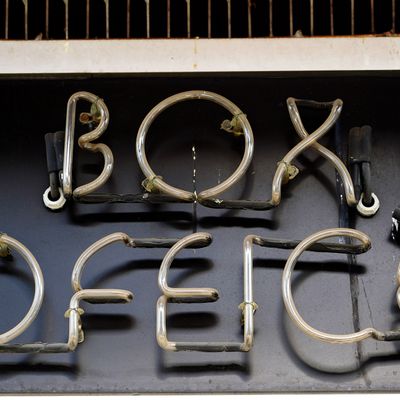
We’ve removed our paywall from essential coronavirus news stories. Become a subscriber to support our journalists. Subscribe now.
On day eight of the theater shutdown, I spoke to an unnamed managing director at a New York theater whose panic was beginning to consume her. She was furious and terrified and bewildered — how was theater going to survive? Why didn’t people understand the existential threat? Even the fast-growing community efforts and GoFundMe campaigns and digital arts initiatives didn’t offer her any comfort — if anything, they heightened her anxiety. “The best of those is, say, raising $30,000,” she said. “The need for these workers is so much much greater than that! They need an agency with more power to step in and address the needs they have, and theater institutions, who are themselves in free fall, are not necessarily able to do that. There needs to be serious government advocacy! I don’t know who that advocate is, and the peers that I’m talking to now don’t know who that is.”
On day fifteen, we know. Theatre Communications Group (TCG) has long been a central resource for its member theaters (around 500 nationally) and individual members (10,000, give or take). It offers conferences, webinars, research and data collection, networking, the magazine American Theatre, and, crucially, advocacy. “We have an advocacy team of one!” laughs executive director Teresa Eyring, referring to Laurie Baskin, the director of TCG’s Research, Policy & Collective Action department. “But with a lot of support from the staff and the board,” Eyring says, “Baskin is working tirelessly to make sure that on the federal level, someone is supporting our arts ecology.” What that actually means is being part of a complicated web of co-advocacy mechanisms, like the Performing Arts Alliance (PAA), a megagroup of trade organizations. (It also means conference calls of staggering length.)
Regardless of membership, in the current crisis, TCG’s constituency is now … all of American performance. It’s not that TCG and the PAA are the only ones fighting for theatermakers. A powerful multipronged effort to get relief bills to include arts sector workers has come from unions like SAG/AFTRA, IATSE, and Actors’ Equity, while issues particular to playwrights are being funneled through the Dramatists’ Guild, since multiunion agreements don’t cover them. But when I spoke to resident theater organizers, many agreed that when it comes to speaking for their concerns, TCG is at the point of the spear.
The actor and playwright Nikkole Salter is a board member of TCG and sits on the council of the Dramatists’ Guild. If it were a normal March, Salter says TCG would be gearing up for Arts Advocacy Day, when arts lobbyists descend on the Hill to argue for everything from the protection of wireless microphones from interference to improving the artists’ visa process. “That’s the work they’ve always done,” says Salter, “and now that whole department has ramped up. A lot of what I learned about advocating with my senators in New Jersey is that they need evidence of care — in other words, written notices and letters. Even if the senator personally can see the merit of the request, what they have to do is rally that support, that physical evidence, when they take to their legislative body. So TCG is pushing people to use their voice, use the forms, sign onto the Action Alerts. That becomes a kind of currency as they fight for our request.”
There has been a huge effort to communicate the specific harms and vulnerabilities in the arts, and news about the government response is mixed. After conducting a fieldwide survey, Americans for the Arts estimated the immediate damage caused by the coronavirus and presented the result to Congress: $4 billion. It wasn’t the amount that would make every wound whole, but it was ambitious and it would stanch the bleeding. Of course, you never get exactly what you ask for in negotiations like these, and several of the advocates I spoke with didn’t expect to here. But in the current $2 trillion relief package, the only performing-arts-specific allocations come in at $150 million — $75 million to be disbursed by the National Endowment for the Arts, the other half by the National Endowment for the Humanities. (A further $25 million goes just to the Kennedy Center.) Although $150 million isn’t chump change, it’s only 3.75 percent of the original ask. You could film a season of Westworld with that money; you will obviously not be able to restart an entire sector.
A government relations consultant for cultural organizations, who asked to remain anonymous to protect future efforts, described the bill as totally insufficient, a “drop in the bucket.” (Germany is giving its arts sector $52 billion, for a fun comparison.) There will reportedly be yet another relief package, which does offer hope, though there’s ample evidence that Republicans in the Senate don’t feel that the arts are a critical need. Look at a recent tweet by Nikki Haley, for instance. She lists the meager quantities going to arts groups and asks “How many more people could have been helped with this money?” That betrays a deep ignorance of what constitutes relief, since a healthy arts industry hires human beings in the same way a healthy airline does. But if the rumblings are true, there might be yet more aid on the way — some language has apparently already been drafted, and we should look for something at the end of this week.
Still, even the current bill, as it stands, has provisions that Baskin greets with something like optimism. For instance, when it comes to unemployment insurance, those thousands of emails and petitions actually succeeded. Salter points out that, in New York specifically, the eligibility requirements for unemployment benefits have often been ill-suited to the way a theater artist works: in spurts, in and out of the state, and for multiple employers. The relief bill has made it so that freelancers, gig-economy workers, and contract workers will be covered, and the federal government will add $600 per week to each state’s payout. That battle to enfranchise gig workers in the social net has been a long one, and it’s worth celebrating its (temporary) victory. Median rent for a one-bedroom in Brooklyn is $2,950, though, so there’s still more work to be done. Salter suggests turning your activist energies to state and local politicians. “Those are state sessions of the assembly where many of those unemployment insurance decisions are made,” Salter says. “Local things happen faster. The federal concessions take a minute to pass, but if the state decides to expand it, by next week people can apply … and the following week they can have a check.”
The allowances in the current bill for loans through the Small Business Administration also look promising. Both nonprofits and for-profits that have fewer than 500 employees can get loans, and if those monies are used for payroll, then up to $100,000 will be forgiven outright. For the small places trying to keep from furloughing employees, that’s wonderful news, though it’s a puzzle how it will apply to the big ones. If a 500-employee office spent it on payroll, for instance, wouldn’t that mean giving each worker just $200? It’s also not money that can be used to get that little business back on its feet. How, the government consultant asks, will we pull people back into civic life after stay-at-home orders expire? In New York, at least, the consultant muses, the giant corporations with their comparatively light tax burdens may need to step into the gap.
Baskin notes that the allotments to the NEA, NEH, Smithsonian, and so on are getting attention, but “we don’t need to look only to them for relief — there are multiple avenues in a $2 trillion package, it’s not solely in terms of grants from the NEA.” Another win that arts advocates had been pushing for since 2017, for instance, is the ability to write off charitable deductions even if you don’t itemize your taxes, which, for the small donor, will be a big deal. “I don’t want to paint too rosy a picture,” Baskin says. “The package doesn’t solve the problem. There’s a lot of hurt out there; theaters have had to cancel seasons, cancel galas, furlough their workers. I don’t want to minimize what’s going on. All I am trying to suggest is that it’s not just the $75 million. There are other opportunities beyond that.” For more information, and a provision-by-provision breakdown of the bill, it’ll be posted on TCG’s Advocacy News tab in the next few days.
Activism can be a mighty shield against helplessness and fear. In a recent memo to an embattled staff, a doctor in the thick of fighting the coronavirus referred to the “rapture of action,” and I know many quarantined people who are desperate to taste it. Certainly the advocates that I’ve spoken to have more vigor in their voices than most. Eyring and Baskin refer repeatedly and warmly to the collective nature of their efforts on behalf of the field, and Salter, who has watched job after premiere after opportunity fall into the COVID-19 void, has been taking strength from her long life in organizing too. “I understand the network and the ecology of the theater because of this work,” Salter says. “And seeing how it intersects with government structures has given me perspective, given me hope. I think it’s because I know just how many people are working to provide the net to catch us.”
In a moment when everything breaks down, there’s also a possibility to build something new. Eyring points out that “there is an opportunity now for leaders at the institutional level to rethink how they’re doing things — what their seasons look like, how the art’s delivered, what their partnerships are, both with other organizations and the community.” The not-for-profit model is riddled with its own hierarchies and assumptions, and it could use an overhaul. Corinna Schulenburg, TCG’s director of communications, chimes in from a personal perspective. “As an artist who had a show canceled, as a mother who’s now working as a half-time kindergarten teacher, as a trans woman whose medical care is now considered elective — I’ve thought a lot about this moment,” she says. “I feel this too is a moment of transition, and just as the other one was marked by grief and loss but ultimately led to liberation and joy, we can move into this national transition with some intentionality. We can find joy.”
“One of the things we’re talking about internally,” says Schulenburg, “has been the way in which the scale of this catastrophe — a wholesale shutting down of the field — is only really comparable is the Great Depression. We’re looking at 20 percent or higher unemployment! So what lessons can we find in the Federal Theater Project?” Under the New Deal, the government’s super-spending effort that put America back to work in the ’30s, the Federal Theater Project only accounted for 0.5 percent of the Works Progress Administration spending, which, if you applied that to the current bailout, would come to $10 billion. Schulenburg has dreams for that money. And oh, oh, oh — a new New Deal is a heady thought. We’re still surrounded by the structures the WPA gave us, including dams, bridges, airports, roads — and, yes, our regional theater system. Maybe a new one could bring it back.





